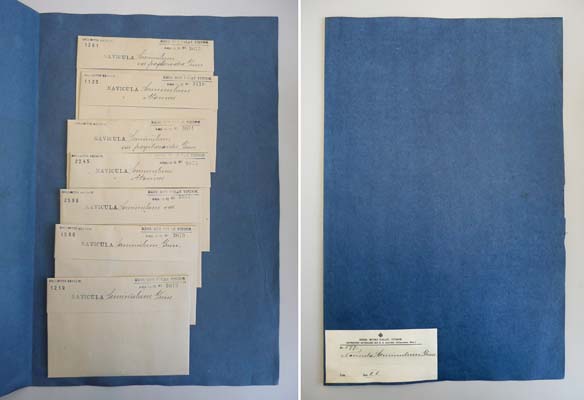The main collection of exsiccatae
In many cases, there is unmounted material of Grunow's samples. Some of these are housed in trays and organized according to the sample number, like the slides. However, many others are present within a taxonomically organized collection in blue paper folders like that shown above. The folders bear a species name on the cover and contain loose envelopes that enclose further, smaller packets, which in turn contain samples dried onto paper, glass or mica. The envelopes are numbered with the year when the material was acquired by the Museum (in this case 1901) and a number, representing the Museum's accession number for that year. However, there is no index for these accession numbers and so, if you want to find all the envelopes containing material from, for example, sample 1580, the only option available is to look through every single envelope in the collection, and there are hundreds of folders and many folders contain several envelopes, The exception is Navicula. Here, the present Curator of Cryptogams, Dr Anton Igersheim, has been through all the folders, opened the envelopes to find out which sample is present, and stamped the envelope with the sample number. So, for example, the folder for 'Navicula seminulum' contains one envelope derived from sample 1580 and this number has now been stamped on the envelope. Furthermore, an Excel spreadsheet is available that lists the Navicula envelopes and gives their contents, and this is an invaluable resource. However, it is quite possible that other envelopes containing subsamples1580 exist somewhere else in the collection besides Navicula; finding these will not be easy, although the lists of species recorded in the accessions books will be a help. And many samples will not have been used to prepare any of the exsiccatae for Navicula species.
The collection of blue folders is arranged alphabetically by genus, and then alphabetically by species. Sometimes, a little 'lateral thinking' is required to locate envelopes, especially where the taxonomy has been particularly unstable (e.g. where taxa have changed in status from species to variety or vice versa).
David Mann, August 2009


